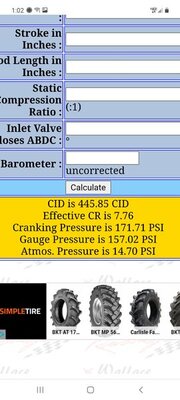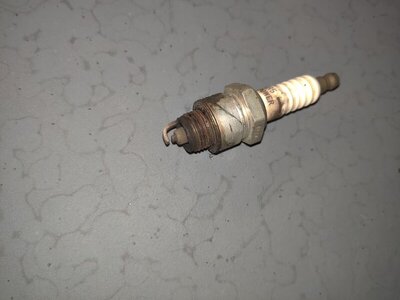Wolf Tickets
Active Member
I've got a 440 that was rebuilt to a good street blueprint by my local shop, Action Machine in Seattle. They say it should be 9.35:1 and run fine even on mid grade gas.
The problem is that I've had to limit my total advance to not more than about 26 to keep from pinging. I've danced around the exact total with changes in outdoor temp. Added a fan shroud which helped a bit. I don't have a temp gauge but the Stant radiator cap with a temp gauge in it never reads over 170 after a hard drive and shut down (then climbs after sitting for a while).
I've got the FBO limiter plate at 14 degrees and my initial somewhere between 10 and 12 (always adjusting these days trying to find the best spot). I'm all in by 2800 but 'all' is only 24-26 degrees so that shouldn't be too much/fast, right? I've attached a picture of the graph I made of the current curve. It's 2 gold springs from FBO. Also a picture of the graph of my old curve - I had one silver and one stock (mp elect distributor, the spring that wasn't the giant loop garage door spring) and that had a better curve, starting sooner and pulled harder from idle. Same limiting plate for same total.
Note the first picture is my old curve, the 2nd one is my current curve, all in by 2800
IT's great on the street but really lacks a top end and never gets better than 11mpg on the freeway without ever pressing the pedal more than 1/8" and keeping it at 60mph.


1973 440 out of a T&C wagon (it got 18mpg and was still fun in that LOW-PO 215hp/340tq setup!!)
Current Setup:
Stock heads
HP exhaust manifolds
Performer RPM intake
comp camp xe262
compression test at 180psi (on third crank over. It basically went 140, 160, 180 and didn't go higher than that.)
3.23 gears
26.6" tires (295/50/15)
holley street avenger 770 stock jets
MP performance electronic dist (basically identical to the stock 73 dist)
FBO ECU and Coil (eliminated ballast resistor)
THANKS a million for any input you can lend. This forum is a goldmine!!!
The problem is that I've had to limit my total advance to not more than about 26 to keep from pinging. I've danced around the exact total with changes in outdoor temp. Added a fan shroud which helped a bit. I don't have a temp gauge but the Stant radiator cap with a temp gauge in it never reads over 170 after a hard drive and shut down (then climbs after sitting for a while).
I've got the FBO limiter plate at 14 degrees and my initial somewhere between 10 and 12 (always adjusting these days trying to find the best spot). I'm all in by 2800 but 'all' is only 24-26 degrees so that shouldn't be too much/fast, right? I've attached a picture of the graph I made of the current curve. It's 2 gold springs from FBO. Also a picture of the graph of my old curve - I had one silver and one stock (mp elect distributor, the spring that wasn't the giant loop garage door spring) and that had a better curve, starting sooner and pulled harder from idle. Same limiting plate for same total.
Note the first picture is my old curve, the 2nd one is my current curve, all in by 2800
IT's great on the street but really lacks a top end and never gets better than 11mpg on the freeway without ever pressing the pedal more than 1/8" and keeping it at 60mph.
1973 440 out of a T&C wagon (it got 18mpg and was still fun in that LOW-PO 215hp/340tq setup!!)
Current Setup:
Stock heads
HP exhaust manifolds
Performer RPM intake
comp camp xe262
compression test at 180psi (on third crank over. It basically went 140, 160, 180 and didn't go higher than that.)
3.23 gears
26.6" tires (295/50/15)
holley street avenger 770 stock jets
MP performance electronic dist (basically identical to the stock 73 dist)
FBO ECU and Coil (eliminated ballast resistor)
THANKS a million for any input you can lend. This forum is a goldmine!!!


















